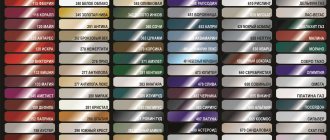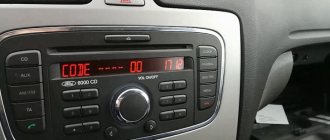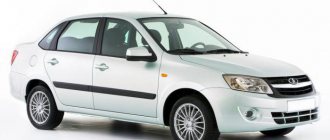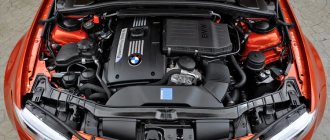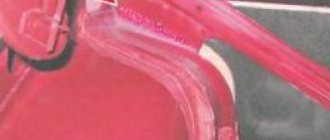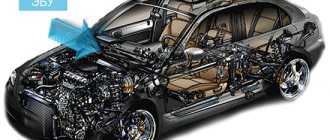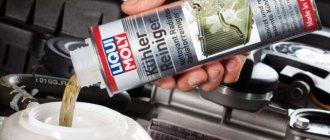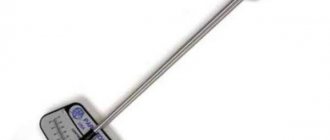Published:
27.01.2016
When purchasing a used car, new car owners do not wonder whether the vehicle’s equipment has been changed. But at the first breakdown, repairs become problematic, because the parts that were purchased for the original engine may not fit your unit. Moreover, without knowing the engine model, you cannot correctly decide on the operating style and purchase of the right consumables. This is where the question of how to find out the car engine model becomes relevant. There are several ways to find the answer to this question.
First way
The very first thing to do is open the hood of your car and take a look at the engine. Most companies leave special markings on its surface. For example, the Mercedes company writes a special code on the unit that begins with the letters OM and three numbers. Volkswagen does exactly the same thing, only the numbers are preceded by another letter part EA. If you found such a designation, now simply enter it in your browser. On the screen you will find complete information about the engine with all its characteristics.
However, unscrupulous sellers erase this marking in order to sell the car at a higher price, claiming a more powerful engine under the hood. If this happens, you will still be able to find out which engine is installed.
What information can be read from the VIN code?
The identification number of any passenger car is 17 characters, each of which encrypts certain data about the car.
The VIN code includes three blocks:
- WMI - index of the automaker and the country of manufacture of the car;
- VDS - description of the characteristics of the vehicle (this is where you should look for data on the internal combustion engine);
- VIS - manufacturer, serial number and year of manufacture of a specific model.
VIN code decoding scheme.
From the VDS block you can read data about:
- body type;
- chassis;
- brake system;
- model and type of internal combustion engine;
- other technical characteristics of the vehicle.
The location of the symbol in the VDS section, which is responsible for the engine index, may differ depending on the car manufacturer.
A plate with the BMW X5 VIN code (the engine type is encrypted in the seventh digit).
The vehicle model year encoded in the VIS block does not always correspond to the actual production date of a particular vehicle.
Where to look for the VIN code
The exact location of the VIN is not regulated - each automaker places the data in those places that it considers convenient for the car owner. You can figure out exactly where the VIN code is located by studying the documentation for the vehicle.
The most popular VIN locations.
Second way
Most often, it is on the left side of the unit (possibly another location) that you can find the traditional engine number. It is very easy to find out the model by the engine number.
The first embossed character indicates the year of production. Please note that on power units that were produced after 2000, the year is indicated by a letter index. The next four symbols indicate the modification of the motor, and the last one indicates climate adaptation. Again, if necessary, enter this code into the search bar and you will find all the information about your unit.
Under this code you will see another one, it is of no value to you. If you are still interested, you can find the explanation of these symbols in the manufacturer's manual.
What is part marking, and in what situations is verification needed?
In Russia, the engine number is entered in the vehicle passport.
It represents the letter code of the motor and a numeric parameter from the factory. The number is fixed between the gearbox and engine on the dividing seam. It can be found on the gas distribution mechanism, or more precisely, on the protective casing. Having opened the hood, just find the above location and find a code consisting of 9 characters:
- Usually it is 3 numbers and 6 letters.
- There are 4 numbers and 5 letters if the manufacturer has sold about 1,000,000 motors or more.
The secondary market is in great demand because most citizens do not have the financial ability to buy new cars.
Purchasing a used vehicle saves money and speeds up the process of receiving the goods.
However, shopping on the secondary market is dangerous, because there is a risk of getting a stolen car or with someone else’s parts.
Therefore, before the purchase and sale transaction, the car is checked by engine number.
Checking is also necessary when registering a car. Technical inspection specialists will analyze the information in documents and in fact for compliance or will resort to the help of a special database.
In the secondary market, the buyer is not protected from a legal point of view. Crime and used cars are a common combination.
What is a VIN number?
VIN code is a unique vehicle identification number. This marking includes 17 characters - numbers and Latin letters, with the exception of I, O, Q (due to the similarity with the numbers 1 and 0), and contains the following information:
- Vehicle manufacturer (first 3 characters);
- Data about the car itself (4-9 characters);
- Manufacturer, year of manufacture, serial number of the car (unique 10-17 characters).
The identification number (VIN) is indicated in the documents for the car - in the vehicle passport and registration certificate. It can also be found on the body of the car itself.
What is VIN for?
Canadian and American car factories began to use it since 1977. To this day, exporters and automakers in these countries follow the ISO 3779 standard, but in the EU, maritime rules for labeling passenger cars are not always held in high esteem.
The character set rules in the identifier are subject to the ISO 3779 and ISO 3780 standards (currently ISO 1983 has been repealed, the new one in 2009 is in effect).
This classification helps to globally determine all TPA data, namely:
- country;
- company;
- brand of transport;
- model year;
- Date of issue;
- place of manufacture;
- body type and color;
- equipment;
- motor type.
The verification digit included in the number prevents unauthorized changes to the code.
Thanks to the presence of a unique code, the machine is easy to “read” and compare with technical documentation. This will help protect the car from theft, and also restore engine data if its markings are not readable for some reason.
And although ISO (International Organization for Standardization) together with SAE (International Association of Scientists, Engineers and DTS Experts) are trying to bring the numbering to uniform rules, each plant acts at its own discretion and keeps records according to its own rules.
Where to find VIN
Where is the unique car number recorded (it is also called the body number, although this is not entirely correct):
- in STS;
- in PTS;
- on integral body and chassis structures;
- on small plates (nameplates).
The car manufacturer specifies all such places in the documents for the vehicle registration certificate.
Each car plant has individual methods for applying a VIN code. But most often it can be found in common places:
- Where the instrument panel meets the windshield is opposite the driver. The number is placed in such a way that it can only be seen from the street.
- Behind the driver's seat at the bottom of the pillar. It is visible when the door is open.
- At the location of the motor, look for a nameplate attached to the partition. It should be clearly visible.
- At the bottom of the luggage compartment (if the body type is hatchback).
- On the chassis in a place where it is easy to find and see.
- Vehicles with a frame structure contain VIN on the side members.
Unscrupulous businessmen take advantage of human inattention and laziness. Who wants to explore all the places described above with a flashlight and a magnifying glass? It is enough to see one easily accessible Vin and check it with the PTS. Therefore, attackers make changes to such a number, and the rest are either erased or covered with rust, without trying to interrupt them.
If you decide to buy an old car, you will have to sweat in search of all possible places of application, especially hard-to-reach ones. Having found a marking plate on the rivets, examine the space around it to see if there are scratches or dents nearby.
Early FordScorpio had a number stamped at the factory, it had a raised appearance. Now the number is applied without deforming the steel sheet. Fraudsters clean off the factory inscription and apply their own marks. Some Mercedes models have nameplates on screws that are easy to replace. You can also find out the VIN code by knowing the state number of the car. To do this, use our service using the link below.
Decoding the VIN code
A VIN code is a unique number assigned to a vehicle at the factory. It contains complete information about a specific car.
It is VIN that is most often used to check vehicles. The code consists of 17 numbers and non-number-like letters, divided into three parts. Let's take a closer look at the decryption:
- 1 character – code of the state where the car was produced;
- 2nd and 3rd characters – name of the manufacturer and type of vehicle. In some cases it is used to designate a division of the manufacturer;
- Characters 4-8 are a description of the car, which includes the model, body type, specification, transmission type and engine information. That is, the eighth digit carries information about the engine model.
- 9th character – control indicator;
- 10th character – year of manufacture in letter designation;
- 11th character – link to the plant;
- 12-17 symbols – serial production number of the machine.
As for where the VIN code is located, firstly, it is in the documentation for the vehicle. If the number was verified upon purchase, then you can safely use it. Second, the code is present in several places on the machine itself:
- Under the floor covering near the driver's seat;
- On the windshield;
- Under the hood;
- On the front drain of the body and other places invented by the manufacturer.
To determine which numbers will provide information about the engine number by vin, you should use either decoders or conversion tables. The second option involves spending a lot of time and does not guarantee finding the correct answer. The engine model is indicated in the form - gasoline ccm kbm. Where the word “gasoline” means that the engine is gasoline. Other symbols and numbers indicate engine power.
When buying a car, it is important to check the similarity of the VIN code in the documents and on the body. If there are discrepancies, the transaction should be abandoned, since the PTS is most likely fake. If you make a purchase at a dealership and discover an error, you should immediately notify authorized employees.
What does the label indicate?
As a rule, the marking consists of 14 characters (but there are exceptions). It is based on 2 blocks – descriptive (6 characters) and indicative (8 characters).
Descriptive:
- The base model index is the first three characters.
- Modification index – if absent, set to “0”.
- Climatic performance.
- The last symbol is P (recirculation valve) or A (diaphragm clutch).
Pointing block:
- Year of manufacture (number or letter). 1-9 indicates the year of manufacture 2001-2009, respectively, A - 2011, B - 2012, C - 2013, etc.
- The next 2 digits are the month of issue.
- The last 5 are the serial number.
Information that will help you decipher can be found in the vehicle’s operating instructions or on specialized websites.
Third way
You can also determine the engine model by the VIN code. This code is the serial number of the vehicle and carries information about all components. This code must be affixed by each manufacturing company. Only in professional service stations can technicians decipher it on the fly. Therefore, use a search on the information network or a specialized reference book.
Why you may need to know information about the engine
Often, when buying a used car, the new owner does not ask the previous owner what power unit is installed in the car, however, this data may be needed in a number of cases:
- when repairing the engine and ordering spare parts;
- to register a car - if the engine type and model do not match the documents, it may be difficult to register;
- to determine the correct operating style of the motor and select the appropriate consumables.
Before purchasing a car, it is recommended to check the details of its engine with the title and registration certificate in order to protect yourself from unpleasant surprises in the future.
Additional methods
It is worth noting that it is not always possible to determine the engine model by the VIN code. After all, even in the information base at the plant there could be an error hidden, and the number is entered by a person, and here the human factor plays a role.
MREO
If during the process of purchasing a car you have suspicions about the engine, they can be checked by diagnostics at the MREO. The car will undergo a full technical inspection at a special institute. If you have a few days to spare, then it is better to use this method.
Take into account the fact that the MREO also has limited possibilities. There are situations when it is not possible to install the engine model.
Specialized service station
Even if the MREO could not help you, then all you have to do is go to a specialized service center. An employee of such a center, using methodological literature and his skills, will find out the model of your power unit. The cost of such a service ranges from 500 rubles to 2500.
Why know the engine model
Many people, when buying a car, do not think about what it actually is. We are talking about the filling or technical parameters. Of course, only specialists have a thorough understanding of cars, but it is advisable to know some basic facts, such as body and engine numbers. Knowledge of the latter may be required in the following cases:
- If you need to look for an engine part, you need to know the brand of equipment.
- Many devices have analogues; if you have an idea of the model, it’s easier to choose something that suits other configurations
- The better the car owner understands the configuration of his car, the less chance the service station employees have to deceive him when repairing and replacing spare parts and parts, and this will ultimately save money.
Knowing the engine modification is really important. The motorist must have a clear idea of how to do this quickly and without outside help.
By finding out the engine model, you can save money on repairs, quickly select suitable spare parts and protect yourself from unplanned expenses based on the tricks of auto mechanics.
Where to look for the VIN number?
Since there are no strict requirements for placing the VIN code on a car, it can be located in different places in different brands and models of cars (the manufacturer usually indicates these places in the documents for the car). Most often, the code is indicated under the hood near the windshield, and can also be located:
- at the junction of the dashboard and windshield on the driver's side;
- on the bottom of the pillar, behind the driver's seat (the marking is visible when the door is open);
- on the chassis;
- on the side members.
Checking engine number
In modern cars it can be quite difficult to get to the engine license plate. To see it, you will need to remove some parts. Therefore, during the registration procedure, the specialist may not focus on reconciling the numbering. But motorists should not rely on luck alone, since everyone can check their data. You should not hope for leniency if the engine number is located in an area accessible to control.
In some regions of the country, the traffic police does not focus attention on the discrepancy between the numbers in the registration certificate and on the engine, provided that the replacement was made with a similar engine. No adjustments are made to the passport, no documentation is required to certify the validity of the replacement, and the vehicle will be registered. But in another region of the Russian Federation, the registration process may be refused due to a mismatch between the PTS and engine numbers. To justify the refusal, government employees refer to Appendix No. 1 of Order No. 605.
Expert opinion
Mironova Anna Sergeevna
Lawyer and lawyer for automobile law. Specializes in administrative and civil law, insurance.
It is not uncommon for a car to have a replacement engine installed, but the registration certificate indicates a different engine number. In this case, to make adjustments to the PTS, you will need to collect documentation for the installed engine and write an application to the traffic police. For some drivers, information about the engine numbering is not included in the registration certificate. The corresponding line is also missing in the application for vehicle registration. The applicant should indicate only the engine power.
What is VIN
VIN (Vehicle Identification Number) is the “Vehicle Identification Number”. It contains seventeen characters - numbers and Latin letters, except I, O, Q due to their similarity with 1 and 0.
VIN consists of 3 parts:
- WMI (World ManufacturersIdentification) – identification of world manufacturers, it is assigned the initial three characters.
- VDS (VehicleDescriptionSection) – section of the vehicle description, occupies the fourth to ninth positions.
- VIS (Vehicle IdentificationSection) – vehicle recognition section, located in the last eight places.
The identifier (of wines) is designed to determine the origin of the vehicle on a worldwide basis and classify it.
It will be easy to figure out what data is contained in the first three characters (WMI). There are many reference books on the Internet that identify the country and plant using these signs. We can only add that if the third character in this group is “9,” it means that the enterprise is small, producing no more than 500 cars per year. For example, WMI of small factories of the former USSR are as follows: RF - X89, Belarus - Y39, Ukraine - Y69, Y89, Y99.
But with VDS there are disagreements between countries. Many manufacturers try to fit too much information into these six characters: body type, model, engine, steering wheel side, transmission, etc. In the USA they even manage to code the weight and available safety features of a vehicle.
In the 9th position of the code (6th according to VDS) there is sometimes a verification number - this is a number or the letter “X”.
It is mandatory in the North American and Chinese markets, in BMW, Volvo, Saab, Lexus, Toyota, MercedesBenz cars. In European countries, this position is considered optional. If the VDS contains less than six characters, then zeros are placed in the empty spaces.
The third set of characters (VIS) carries information about the model year, assembly plant, and factory serial number.
